On Wednesday, Sept. 7, an estimated 1,200 people were scheduled to gather together in San Francisco to be sworn in as United States citizens. It’s an event that occurs every three months in the state’s cultural capital, as well as a number of other cities around California. San Francisco alone naturalizes about 25,000 people per year.
Despite the steep number of participants, each event is an emotional affair, according to Sharon Rummery, regional media manager at U.S. Citizenship and Immigration Services. She recommends bringing a handkerchief to swearing in ceremonies, if you happen to be in town.
But the path to citizenship for someone not born in the United States isn’t as simple as asking for it. It’s a journey that starts with filling out an N-400 Application for Naturalization and continues with an interview, a test to determine that the applicant can write and speak basic English, as well as a 10-question exam that addresses United States history, politics, and geography. The entire process takes, on average, 4.3 months, according to the United States Citizenship and Immigration Services (USCIS) website.
It was the naturalization test that interested us, with 10 questions randomly selected from a pool of 100, and a mandate that six correct answers out of 10 passes. Currently, the pass rate is 92 percent. And the questions are readily available online for study beforehand. Also, applicants are given two opportunities to take the test. If they fail on the first try, they have between 60 and 90 days to retake the portion they failed.
And after 20 years of using the same questions, USCIS officials recently revamped the exam and started administering the new test in October 2008. According to Mariana Gitomer, a USCIS Public Affairs Officer, the department coordinated with the community to make the test “more meaningful.”
Rummery agrees with this assessment.
“The old test would have one right answer. When we made the new test, we made it a little bit different. On the old test it would say ‘Who was Martin Luther King?’ and the answer was he was a civil rights activist. The new test says ‘What did he think?’ That is a far more-reaching question.”
But even with a good chance at passing and the recent facelift, we found ourselves wondering precisely how relevant the test was to life as an everyday American citizen. We didn’t know many of the answers offhand, and wondered if it was truly fair to expect more of the newly naturalized American citizens than of ourselves. On top of that, almost daily there are new reports of presidential candidates flubbing important historical dates and facts.
Most notably, in Boston, Mass., Sarah Palin gave a severely inaccurate account of Paul Revere’s famous ride; Michele Bachmann confused Concord, N.H., and Concord, Mass., when discussing the Revolutionary War; and Herman Cain mixed up the United States Constitution and the Declaration of Independence when encouraging Americans to reread the Constitution and specifically the part that addresses “life, liberty, and the pursuit of happiness.”
So we took the test to prominent local citizens and politicians to see how they fared, and whether they thought the questions themselves were a fair and accurate determination of who we are as Americans and what we ought to know about our nation.
Pat Harris
If Pat Harris, chair of the San Luis Obispo County Democratic Central Committee, actually had to take a citizenship test, she’d probably ace it. While sitting down with New Times, she answered 20 out of 20 questions correctly, but she still doesn’t think the test is a great measure of true citizenship.
“I think if there was more emphasis on what makes America, America, it might be a better way to figure out if people are ready to be citizens,” she said.
In fact, Harris barely stumbled over the questions we threw at her.
How many voting members are there in the U.S. House of Representatives?
Easy: 435.
If the president and vice president can no longer serve, who becomes president?
House Speaker John Boehner, she answered nonchalantly, then muttered, “frightening.”
Is the test relevant?
“No,” Harris said.
Not that the information is unimportant, she added, but in the age of the Internet, there’s no reason to memorize how many U.S. representatives there are, for example, or how many Supreme Court justices serve, even though she knows there are nine and John Roberts is the chief justice.
There was one question that tripped her up at first: What does the judicial branch do? Of course, Harris correctly answered that it decides whether laws are constitutional.
“That was kind of a hard one,” she said of the question. “It seems easy.”
But maybe the test isn’t aimed at testing American-ness, she wondered after we were done quizzing her.
“My view is that there are a lot of obstacles that the government puts up. … It’s not a real welcoming country at this point.”
Joni Gray
“I can’t believe I’m doing this.”
Santa Barbara County 4th District Supervisor Joni Gray expressed some doubt while being quizzed, but she had nothing to worry about. Aside from getting a couple of questions absolutely handed to her by random selection (“What is the date of Independence Day?”), she had an advantage. She’s not just a supervisor; she’s a lawyer. Her résumé also includes—and this may have been her ace in the hole—her time as a history teacher at Santa Maria High School.
Still, the softballs kept coming: “What is the capital of your state?”
“If I didn’t get that one right, you’d have to write a six-page story on what’s wrong with Joni Gray,” she said.
The 4th of July question was followed by “Independence from whom?” She also got “Where is the White House located?”
Swish! Nothing but net.
In all, Gray correctly answered nine out of 10 questions, citing the electoral college as electing the president of the United States, naming several guaranteed rights or freedoms of U.S. citizens, highlighting what the Emancipation Proclamation accomplished, and explaining the Bill of Rights: “It’s a bill that guarantees the individual rights of the states and the people, and it defines those individual rights, which are protected by the federal government.”
Gray then pondered one more question: the one driving our journalistic exercise in national knowledge and its application to people hoping to become citizens. For a onetime history teacher, she said something surprising. Parents, cover your students’ eyes: “How relevant is it to know historical information? Isn’t it more important to know how to write a check, how to balance your checkbook, and how to drive a car?”
Mark Bryan
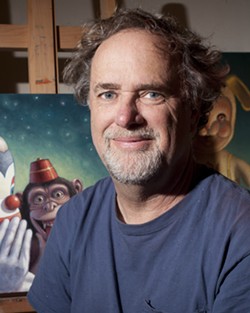
- PHOTO BY STEVE E. MILLER
- MARK BRYAN : The artist known for political works like Mad Tea Party (though he estimates only a quarter of his work is political) had no problem answering current citizenship questions.
Known just as much for his political satire as for his surreal disaster scenes, burlesque rabbits, and unicycling monkeys, local artist Mark Bryan would have no trouble passing a citizenship test. When a New Times reporter phoned him unawares in his studio, Bryan correctly answered nine out of 10 questions pulled straight from the test.
Off the top of his head, Bryan could tell you the purpose of our Constitution (to set up government), its first three words (“We the People”), how many amendments it has (27), and the name given to its first 10 amendments (The Bill of Rights). But question No. 1, “What is the supreme law of the land?” tripped him up. Answer: The Constitution.
Bryan pointed out that the question’s wording gave the indication that its answer would be one specific law—not an entire document of them—and it’s difficult not to agree with him there. But as any would-be citizen need correctly answer just six out of a possible 10 questions, he would have passed either way.
It figures that any political artist worth his or her salt would know most of these answers. But Bryan, perhaps most infamous for his searing piece Mad Tea Party (followed by Mad Tea Party, Part D’uh after an American populist movement appropriated the term in 2009) estimates only about a fourth of his art is political. His scathing, surrealist satire, Bryan told New Times back in April, typically only emerges “when something pisses me off, or I get a particular idea.”
And while the artist may ruffle conservative feathers here and there, his freedom do so is fully protected under the First Amendment—to the utter delight of the art world.
Matt Kokkonen
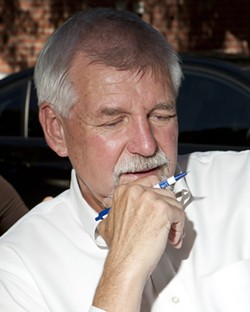
- PHOTO BY STEVE E. MILLER
- MATT KOKKONEN : This Republican activist and past political candidate took the test before—and obviously passed—after his immigration from Finland. He did great this time, too.
San Luis Obispo-based financial planner and Republican activist Matt Kokkonen has a lot to say about the citizenship exam. In fact, he’s taken it before.
Born in Helsinki, Finland, Kokkonen immigrated to the United States when he was 16 years old. Before he became a U.S. citizen, Kokkonen took—and of course, passed—the U.S. Citizenship exam, though he claims to remember very little about it.
Sure, we thought, when he agreed to sit down and face-off on the test with a New Times reporter, in what would become a closely matched duel of wits, minds, and all-around American patriotism.
Kokkonen passed with flying red, white, and blue colors—100 percent correct. It took him a while, though, as questions regarding hot-button Tea Party issues such as the powers of states, citizens’ participation in their democracy, and of course, taxes, were sometimes answered in a little more detail than necessary, but were nonetheless correct.
The New Times reporter, however, didn’t fare as well, missing one out of the same set of 20 questions regarding the Constitution, rights and responsibilities of American citizens, and American history that Kokkonen sliced through with his pen like a scalpel.
What group of people was taken to America and sold as slaves?
“Generally negroes, because they didn’t all come from Africa,” he replied.
An example of Kokkonen’s attention to detail is his response to Question 56: “When is the last day you can send in federal income tax forms?” Easy, right? April 15.
“Well, technically, it’s April 15 or the very next business day,” Kokkonen said, noting that, in 2010, Tax Day landed on a Saturday, and filed returns would not have been processed until that Monday. “Or it could be the deadline of your extension.”
“Show-off,” the reporter grumbled under his breath. To his credit, the reporter only missed Question 51: “What are two rights of everyone living in the U.S?” Apparently the right to pursue happiness is not on the answer key, because it’s not in the Constitution, but instead listed in the Declaration of Independence. Technicalities!
Larry Lavagnino
Age matters, apparently.
As he geared up to participate in this experiment, Santa Maria’s Mayor Larry Lavagnino commented on his, ahem, longevity.
“I’m so old, we had to pass the constitution test to graduate from high school,” he said. “Let’s see if I remember anything.”
Remember he did, though his, uh, advanced years were probably more of a boon to him than a hindrance.
“You’re giving me questions I lived through,” he quipped when asked about which three countries the United States fought against in World War II. Not surprisingly, he answered that question correctly. He went on to knock the rest down, one after the other. One branch of the U.S. government is the executive. The Declaration of Independence declared to England that we were going to be our own sovereign nation. The Civil Rights Movement strove to end racial discrimination.
How about the two major political parties in the United States? He chuckled for a while before saying, “You’re kidding me, right?” He dutifully cited Republicans and Democrats—then added: “But the Independents and decline-to-states are gaining on them.”
So it is possible to be grounded in the past but still have a grasp of the present.
Lavagnino’s one possible misstep came from this question: What was the major concern during the Cold War?
“We feared retaliation from Russia,” he said, “that they would attack us with atomic bombs.”
The answer we had was a concise “communism,” but who’s bickering about that?
Brian Reynolds
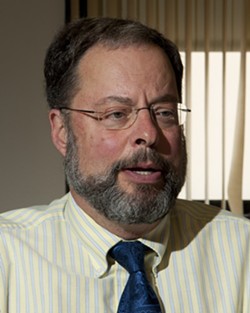
- PHOTO BY STEVE E. MILLER
- BRIAN REYNOLDS : The director of the San Luis Obispo County Library is dedicated to disseminating information to the community so it’s no surprise that he passed the citizenship test.
Here’s a fun fact: You don’t need to prove citizenship to get a library card here. At least, that’s what Brian Reynolds said, and he’s the director of the San Luis Obispo County-City Library.
“Because it’s our mandate to help people learn, and it’s not up to us to say if they deserve to learn,” Reynolds said.
As for questions 21 through 40 of the citizenship test we brought to him, Reynolds answered all but two correctly—three if you want to get technical.
Asked what the judicial branch does, Reynolds said, “They balance the other two, I think is how it’s supposed to work.”
And while we might consider that correct, or at least correct-ish, the answer the U.S. government wants is one of the following: reviews laws, explains laws, resolves disputes, or decides if a law goes against the Constitution.
Reynolds flubbed the number of U.S. representatives (he guessed 450 but there are 435), and for how long a U.S. representative serves (he said six years but the correct answer is two years).
For Reynolds, a man who lives and breathes information as part of his job, he guessed that most U.S. citizens would be able to pass the test, even if there are a few facts they might have forgotten.
“I would think they would know most of them, but they might not get them right because it might have been years ago that they studied this stuff,” he said.
José Ortiz
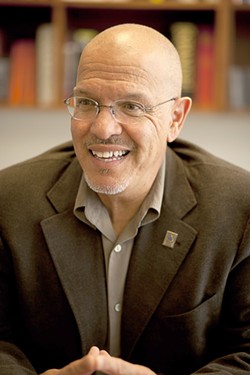
- PHOTO BY STEVE E. MILLER
- DR. JOSÉ ORTIZ : Allan Hancock College’s president would pass the citizenship test if he took it today—despite such joke answers as “Tom Hanks” for “Who said ‘Give me liberty, or give me death?’”
The president of Allan Hancock College sensed some trouble.
“Well I suppose I could be setting myself up, but OK,” he said when asked to take the test.
He laughed out loud when he heard the first question—What do the stripes on the flag mean?—and realized his answer wasn’t immediately forthcoming. He responded, “I don’t know. Unity, or something.”
On-the-spot pressure can do that to a person.
Though he decided to take a tongue-in-cheek approach to the test, he still passed, successfully pinning down how many terms a president can serve and the like. But his victory came despite these attempts:
Who becomes president of the United States if the president and the vice-president should die?
“I want to say Speaker of the House, but that doesn’t sound right. I guess I’ll say the First Lady.”
Which president is called the “Father of our Country?”
“Alfred E. Newman.”
What holiday was celebrated for the first time by American colonists?
“Halloween—just for smiles. OK, I know the answer is Thanksgiving.”
And finally: Who said, “Give me liberty or give me death?”
“Tom Hanks.”
Gail Lightfoot
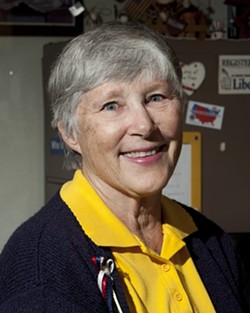
- PHOTO BY STEVE E. MILLER
- GAIL LIGHTFOOT : The local Libertarian passed the citizenship test with flying colors—and why shouldn’t she? She keeps three copies of the Constitution in her house and car.
It’s no surprise that Gail Lightfoot, a charter member of the Libertarian party who’s running for U.S. Senate in 2012, blazed through the questions as if she’d just taken a class on American government.
“I keep three copies of the constitution in my house,” she said, including one in her car. You never know when you might need to confirm a quote or fact, and good citizenship is all about being well-informed, after all.
What are two cabinet level positions? Among a host of possibilities—among them secretary of agriculture, secretary of commerce, and secretary of education—Lightfoot correctly responded with secretary of defense and secretary of labor.
How many justices are on the Supreme court? Nine. Correct.
With nine out of 10 questions correct, Lightfoot hadn’t even cracked a sweat. Then came this question: “Under our Constitution, some powers belong to the states. What is one power of states?” The appropriate answers, according to USCIS, are to provide protection, provide safety, give a driver’s license, and approve zoning and land use. Lightfoot took issue with that.
“All [the Constitution] says is what they can’t do,” she said. “Actually, it’s a bad question to ask new citizens. States are empowered by their state constitutions. That question encourages people not to realize that more power should be in the hands of the localities.”
But for the most part, Lightfoot thinks the test covers a lot of important bases for people who hope to become U.S. citizens, specifically praising the fact that it provides a general overview of U.S. history.
John Peschong
John Peschong may have had an advantage taking the citizenship test in the New Times kitchen. As chairman of the SLO County Republican Party, he’s involved in outreach to immigrants interested in becoming U.S. citizens. This includes helping them along the path to citizenship.

- PHOTO BY STEVE E. MILLER
- JOHN PESCHONG : The chairman of the SLO County Republican Party, who’s involved in outreach to immigrants interested in becoming U.S. citizens, got 10 out of 10 on the test.
So when we asked him a sample 10 questions, Peschong aced every single one.
What is the name of the vice president of the United States now?
“Joe Biden from Delaware,” he replied.
And if the president can no longer serve, who becomes president?
“The vice president.” And Peschong can list the next dozen or so figures in the chain of command as well, though the test would never ask it.
“Where I get confused is number 15, 16,” he admitted.
What he’d like to see are a couple of questions pertaining to the process of turning a bill into law, which are currently part of the test. Over the course of his outreach, Peschong said he’s witnessed a lack of understanding about this process, which can make it difficult for people to become involved in the political process once they are, in fact, citizens. But generally, he thinks the test is an important step for would-be citizens to take.
“It’s part of a multi-tiered program, so it’s just one part,” he said. “You can’t wrap everything Americans are in 100 questions. As part of an overall path to citizenship, I think it’s valuable.”
Send comments, questions, queries, and inevitable rants to Managing Editor Ashley Schwellenbach at [email protected].
Comments